This in-depth analysis delves into the world of Scrum and Agile methodologies, their notable advantages, potential challenges, and practical aspects of their incorporation within businesses. Gain valuable insights into how these methods can revolutionize your company’s project management approach.
Introduction
Navigating the complex waters of project management, businesses are embracing Scrum and Agile methodologies due to their adaptability and customer-focused approach. However, effectively leveraging these tools requires a deeper understanding of their principles, benefits, challenges, and the nuances of their implementation within corporate contexts.
This guide aims to unravel these aspects, helping businesses make informed decisions about their project management strategies. Let’s dive into the intricacies of Scrum and Agile methodologies.
Table of Content
- Understanding Scrum and Agile: An Introduction
- Advantages of Incorporating Scrum and Agile
- Potential Challenges in Scrum and Agile Adoption
- Implementing Scrum and Agile in Corporate Settings
Understanding Scrum and Agile: An Introduction
Agile and Scrum methodologies are increasingly dominant paradigms in project management, particularly in the realm of software development.
Agile, the umbrella methodology, champions adaptability and collaboration, endorsing swift and continuous delivery of value to customers. Within Agile, Scrum emerges as a prevalent framework, characterized by short iterative cycles known as sprints, and distinct roles and meetings to facilitate project progression.
Advantages of Incorporating Scrum and Agile
Adopting Scrum and Agile methodologies can significantly transform project management operations. Here are their chief benefits:
- Enhanced Collaboration: Agile methodologies promote a high level of interaction among team members and stakeholders, leading to more synergistic and effective project teams.
- Improved Quality: The iterative nature of Scrum allows for frequent reassessment and refinement of project deliverables, leading to superior product quality.
- Risk Management: Regular feedback and incremental development inherent in Agile and Scrum aid in early identification and resolution of potential issues, significantly mitigating project risk.
- Customer Satisfaction: By focusing on delivering continuous value to the customer, Agile methodologies enhance customer satisfaction levels.
Potential Challenges in Scrum and Agile Adoption
Despite numerous advantages, Scrum and Agile methodologies present their own share of potential hurdles:
- Commitment of Resources: The necessity of frequent meetings, planning, and revisions in Agile and Scrum requires considerable commitment of time and resources.
- Potential for Insufficient Documentation: Agile methodologies may lead to less emphasis on comprehensive documentation, posing potential difficulties in project tracking and future reference.
- Organizational Culture Change: The transition to Agile or Scrum involves more than just a shift in project management tactics; it necessitates a significant change in the organization’s culture and mindset.
Implementing Scrum and Agile in Corporate Settings
The successful integration of Scrum and Agile in a corporate environment requires thoughtful planning and execution:
- Training and Skill Development: Ensuring that all team members possess the requisite knowledge and capabilities to operate under these methodologies is critical.
- Cultural Adaptation: Efforts should be directed towards creating an organizational culture that embraces transparency, collaboration, adaptability, and continuous improvement – all core values of Scrum and Agile.
- Review and Iteration: The efficacy of Scrum or Agile implementation should be reviewed regularly to identify potential gaps and areas for improvement.
Conclusion
Embracing Scrum and Agile methodologies is a strategic choice that can propel a business towards more efficient project management, enhanced team dynamics, and improved customer satisfaction. While challenges may arise, they can be successfully managed with effective training, cultural adaptation, and ongoing review and refinement.
At TopD Learning, we provide comprehensive Scrum and Agile training courses designed to help businesses navigate these methodologies and integrate them effectively into their project management approach. Leverage our industry-leading training to embark on your journey towards successful Scrum and Agile adoption. Stay abreast of future trends with TopD Learning – your trusted partner in IT and Project Management training.


